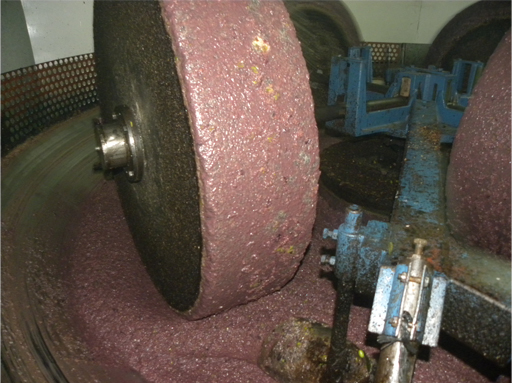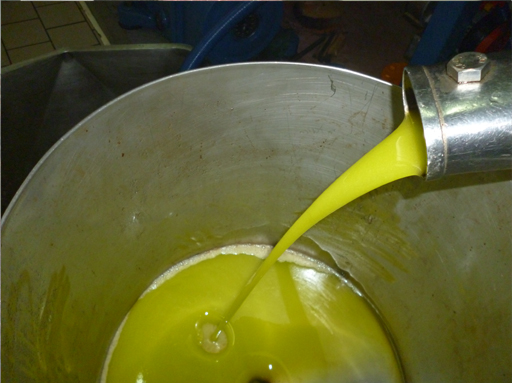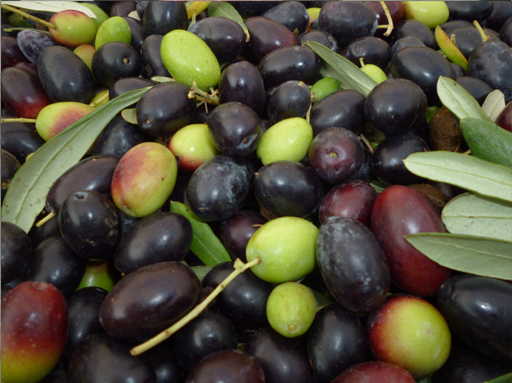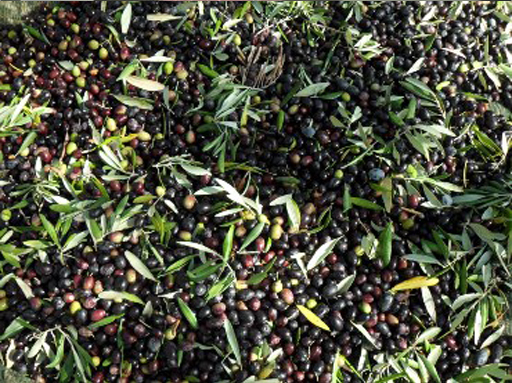THE EXTRAVIRGIN
• The secret of a great oil
|
 |
The secret of a great oil
The oil Extravirgin Joe is the result of better knowledge and work experience in the field of olive, which has been able to combine tradition and innovation. Thus, although the farm Iacovelli Joseph does not have a mill of his own, however, is able to guarantee a top quality oil because cares and monitors the production in all its phases, from the source, providing the authenticity and exclusivity that you can find only in producer-consumer relationship.
Our farm, in fact, over the years has increasingly turned its attention to improving its product, and its own small size allows us to personally follow the various stages of growing and processing of olives, not focusing so much on excessive and very often little precious quantities, but giving more attention to the quality of our cultures.
So for us, the production of a good oil starts since a careful pruning, that depriving plants of unnecessary sarments allows you to control the production of olives and prepare it to the best ripening conditions. So periodic interventions fertilizing, spraying and irrigation give lymph and protection to our plantations. In particular, prudent investment strategies have led the company to equip themselves in time of its artesian wells, which are essential to ensure a good and constant watering, especially during dry summers of our Mediterranean climate. Our plants are always so well-fed and constantly monitored so that they can bring the best fruits.
Between November and January the harvest, practiced with modern techniques but not too invasive so that it could affect the genuineness of the fruit or the health of plantations. But not all the olives are intended for milling. Unlike most other oils on the market, obtained by pressing of all other olives stired without proper selection, Joe Extra Virgin oil is produced exclusively from our best olives, which are selected at the time of collection to the same type, quality and right time of ripeness. The company, in fact, to support the cost of production has always aimed to obtain high yields ( the ratio between the amount of pressed olives and the quantity of oil obtained from them), which may be guaranteed only by the best fruit, triggering so a strategy that returns at the same time to the benefit of the producer and the consumer.
The pressing of the olives within 24-48 hours of collection preserves the flavor of the cultivars and allows to obtain a extremely low acidity extra virgin (only 0.2%). The absence of treatments fitofarmacologich in the months preceding the harvest and full traceability of our products are our brand of quality, ensuring an oil with organoleptic properties equal to those of an organic production.

It is this spirit that has animated our company and we have tried to communicate through the choice of our brand, American translation of the name of the company founder the sign of a productive enterprise that aspires to be updated based on the most recent trends of the market, without denying its origins, and that renews but does not erase the traditional amount of experience that always guarantees authenticity and excellence.
The Cultivar
Just because the olives for milling are selected at the time of collection, the company, meeting the various needs of its consumers, has taken steps to diversify production based on two main cultivars of the land of Bari: "coratina" and "the ogliarola".
Coratina also known as "Top of Corato," cultivar "Coratina" has spread throughout the countryside north of Bari. It is a long-lived plant that easily adapts to various soil types, even those calcareous and stony. Its oil, of medium - large, weighs about 4 grams and reaches its optimum stage of maturity when it assumes a blackish shade of purple. The resulting yellow oil with shades of green and gold reflections, whose chief characteristic is its strong and intense flavor so much so that often it is used to "cut" other varieties of oil with poorer personality. In fact, the oil coratina has a strong fruity flavor, with a spicy and slightly bitter aftertaste, appropriately moderated by a good watering during the year and a careful comparison of the aging time. These characteristics that can sometimes find unprepared delicate palates are justified by the high concentration of polyphenols, antioxidants that prevent the onset of diseases in the cardiovascular system and that delay the aging of cells, making this one of the most valuable and healthy oil .

Ogliarola Bari also known as "Paesana", "Nostrana" or "Cima di Bitonto", this cultivar is widespread, especially in the north-west of Bari. Plant of medium vigor, fruiting branches pendulous foliage and medium thick, is grown on shallow soils and limestone-free, ensuring good productivity but alternating. Its olives, weighing just over 2 grams, are black, with late inoilization (late November) and climb, but with good yields. The results is a yellow virgin gold, characterized by a fruity and almond aroma , much appreciated for its delicate taste and a little bitter, which makes this oil ready for the consumption unlike others who need a stabilization period to achieve the balance of tastes

Chemical-analytical properties
To test the quality of our oil we also subjected it to chemical analysis, of which we report here and comment on the key parameters, which can also be found on our back label.
| Acidity | 0.28 |
| Number of peroxides | 4.7 |
| K 232 | 1.93 |
| K 260 | 0.15 |
| Δ K | -0.002 |
| Oleic acid | 79 |
| Saturated fat | 13% |
| Monounsaturated fatty acids | 80% |
Acidity The acidity of the oil is a non-specific parameter that measures the amount of free fatty acids in oils and which is conventionally expressed in% of oleic acid. It should be emphasized that the acidity of an oil is an expression of something that the human body is not able to assess their senses therefore should not be treated as the other flavours (sweet, bitter, salty), so it can only be determined through 'chemical analysis. Therefore, many consumers mistakenly associate the acidity of the spiciness present in different intensity in almost all extra virgin olive oils. The sensation of spicy or pungent that is felt in the manufacture of fresh juicing does not depend on 'acidity, and a spicy oil as the variety mono cultivar Coratina JOE is much rich in polyphenols a very important class of aromatic substances with antioxidant properties and by' high nutritional value that is at the same time responsible for the spiciness. Extra virgin olive oil produced from healthy olives and harvested at the right level of maturity, using correct techniques for the collection, processing and storage will have a very low acidity. The acidity of an oil increases when the olives are damaged, or when the product has been made from olives and let it fall to the ground long enough to 'trigger the phenomena of fermentation involving the liberation of fatty acids. By subjecting our oil to chemical analysis we obtained an acid value equal to 0.28%, well below the limit value of 0.8% set for extra virgin olive oils. This first finding confirms the quality of extra virgin olive oil JOE that is produced exclusively from selected olives when harvested and milled in a period not exceeding 24 hours.
Number of Peroxides The peroxide is a chemical parameter associated with fats and related to the oxidation state of the lipid components, denoting its potential tendency to rancidity. The polyunsaturated fatty acids contained in an oil give rise with time to the phenomenon of rancidity oxidative that leads to the formation of hydroperoxides. The fat therefore rancid acquires an odour and unpleasant taste until becoming inedible. The peroxide thus indicates an alteration of oxidative synonym of degradation and aging, expressed in milliequivalents of active oxygen per kilogram of oil (meq O2/kg). The limit on the number of peroxides is 20, above which the oil is "clear", while a good value is below 10-12. There are several factors which contribute to the range of autoxidation reactions: the presence of oxygen, light, heat, presence of free radicals, and the high presence of fatty acids. The extra virgin olive oil JOE has encountered as a result of chemical analysis of a number of peroxides very low (4.7), this means that our oil is properly maintained so as to largely maintain its properties over time, limiting the alteration of oxidative type and rancidity phenomena’s.
Spectrophotometric Analysis This exam as well as providing useful elements to judge the quality of an oil, allowed to permanently solve the problem of recognizing the oil rectified extra virgin olive oil if necessary, using the fact that the natural oils do not contain pressure conjugated double bonds that are formed instead, even though slightly, during the grinding process, particularly during the decolorization on active earth. Consequently the adjusted present values of absorption in the UV, particularly in the area around 270 nm, significantly higher than those of virgins. In fact, the isolated ethylene groups, or carboxyl groups of the fatty acids, have absorption maxima between 175 and 185 nm, that is outside the usable area of the UV spectrum which begins, at wavelengths exceeding 200 nm. However, the formation of hydroperoxides of polyunsaturated fatty acids due to a not good preservation, and then to an ongoing process of rancidity causes a shift of the double bond with formation of a conjugated diene system which absorbs at 232 nm. Even the formation of ketone compounds, by oxidation even more pushed, causes a greater absorption that occurs around 270 nm. Therefore, the examination of an oil with ultraviolet spectrophotometry not only allows you to check the possible addition of oil rectified to an extra virgin olive oil, but also allows you to obtain information on the quality of the fat, its state of preservation and changes induced by technological processes.
The UV examination is conducted on the oil dissolved in an appropriate solvent (isooctane or cyclohexane) in the range between 220 and 280 nm. The most significant wavelengths are 232, 262, 268 and 274 nm. The absorption values are expressed as the specific absorbance, meaning with this expression the absorbance at a certain wavelength, of a 1% solution of the oil in question in the chosen solvent, observed in a tank with a thickness of 1cm. The following table contains the limit values of K232, K270, AK for each category of oil.
| CATEGORY OF THE OIL | K232 max | K270 max | AK max |
| Extra virgin olive oil | 2.50 | 0.22 | 0.01 |
| Virgin olive oil | 2.60 | 0.25 | 0.01 |
| Oliva prime | - | 0.25 | - |
| Refined olive | 3.40 | 1.20 | 0.16 |
| Olive oil | 3.40 | 100 | 0.13 |
| Refined olive-pomace | 5.50 | 2.50 | 0.25 |
| Pomace oil | 5.50 | 2.00 | 0.20 |
Submitting our oil to 'Spectrophotometric analysis we obtained the following values: K232 (1.93), K270 (1.50), AK (-0,002). How can I verify from the table, the extra virgin olive oil JOE obtained values well below the limits for the category of extra virgin olive oils. This does nothing but demonstrate through a much more accurate test the quality of our oil, an oil obtained exclusively from Italian olives without any cutting or mixtures with oils belonging to categories lower (common olive oils, oils striking, refined oils). At the same time this test is to prove that to produce extra virgin olive oil JOE, times are observed for just a proper pressing of the olives, and all procedures for proper preservation of the finished product, thereby avoiding unpleasant phenomena of oxidative rancidity that range to alter the quality of the fat.
Characterization of Fatty Acids To reassure our consumers on the quality of the product they are buying we have subjected our oil to further chemical analysis which consists in the characterization of the composition of fatty acids by gas chromatography. Fatty acids are divided into two categories: unsaturated fatty acids ( without the presence of double bonds), and saturated fatty acids (which have double bonds). In the natural lipids are found only unsaturated fatty acids and monounsaturated fats in the cis form or unconjugated double bonds (meaning, close to one another). This general feature that suffers only a few exceptions of very slight extent, is of particular importance in the differentiation of natural lipids such as virgin olive oil, from those who have experienced the industrial processes of grinding or of esterification artificial. These processes in fact cause a certain percentage of trans fatty acids (by isomerization of the cis form) and conjugated double bonds (dienes or trienes), for which the finished product is no longer identical to a natural lipid, nor from a analytical point of view, nor from a biochemical and nutrition point of view .
An example of this is oleic acid (cis-9-enoic-ottadeca) very popular in the extra virgin olive oils with a percentage between 60% and over 80%, easily assimilated by the body, while his called trans-isomer elaidic acid is not. The elaidic acid (trans-ottadeca-9-enoic), while being very similar to oleic acid has different physical properties and it is practically absent in natural lipids while it is found in the esterified oils and to a lesser extent in the ground. Therefore, according to nutritionists elaidic acid is metabolized in the body very differently from oleic acid. Olive oils are also characterized by a higher proportion of unsaturated fatty acids or monounsaturated compared to other natural fats. The low content of polyunsaturated fatty acids is very important because it is indicative of a low tendency to autoxidation phenomena induced by enzymes (lipossidasi), and spontaneous instead favored from external activators (heat, light, cooking).
These reactions determines a series of transformations, whose most striking feature is the negative organoleptic characteristics collectively referred to as rancidity. Therefore subject to rancidity for autoxidation all lipids containing polyunsaturated fatty acids, the speed and consistency of the process are proportional to the degree of unsaturation. An oil rich in oleic acid therefore is more stable at high temperatures compared to another rich in polyunsaturated fatty acids; for this reason the olive oil has a high smoke point and is particularly suitable for frying. The resistance to light, air and heat, reduces the formation of products of lipid peroxidation, which have proved particularly harmful for human health.
By submitting extra virgin olive oil JOE to the characterization of fatty acids by gas chromatography there was a percentage of oleic acid 79% so very close to 83% maximum value in an appreciable extra virgin olive oil. Other hand classifying fatty acids into saturated, monounsaturated, polyunsaturated, the following values have been found : 13% of total saturated fatty acids, total monounsaturated fatty acids, 80%, and just 7% of polyunsaturated fatty acids.
Through this page and the data obtained by chemical analysis we want to reassure our customers about the quality of the product they are buying, and at the same time we want to inform them about the parameters that should be taken into account when you buy an extra virgin olive oil. We invite to pay attention to the products marketed as extra virgin olive oils (often at reasonable prices) and which are in fact the result of mixtures with oils belonging to lower categories (adjusted, refined, etc..) or mixtures with oils coming from other countries where the same procedures in the collection and maturation of the fruit are not followed.




